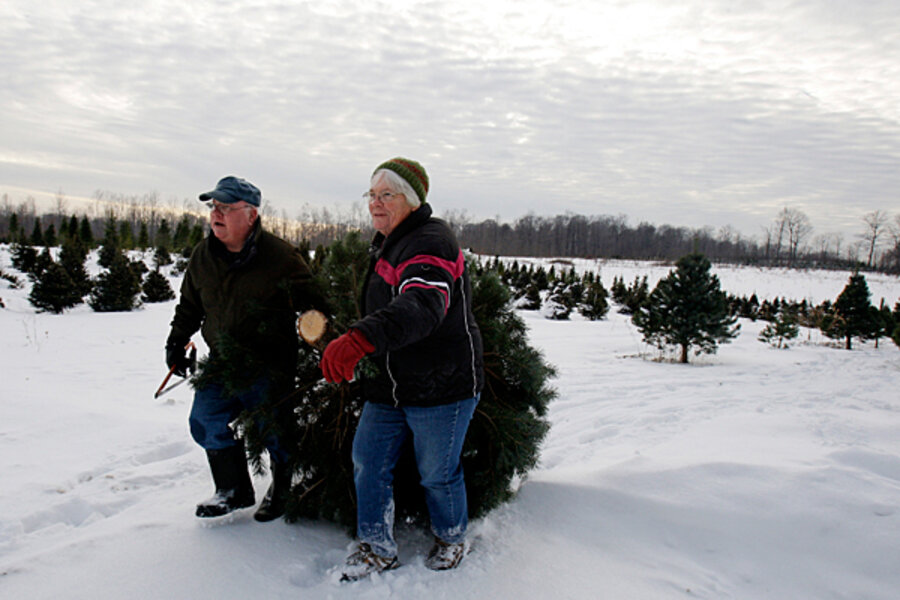Real or artificial? The great debate about Christmas trees in 2010.
Loading...
| Rochester, N.Y.
When it comes to Christmas trees, Americans are firmly divided into two camps: real and artificial.
“Christmas wouldn’t be Christmas without a real Christmas tree,” says Jack Moore, co-owner of Gro-Moore Farms in Rochester, N.Y., as he sold the last of his potted evergreen topiaries to a customer. “The smell, picking out the tree as a family – it’s all about family, tradition.”
But for anyone who’s scrambled to steady a toppling tree and vacuum fallen needles, it’s also a bother. “There’s a lot of hassle with a natural tree,” says Thomas Harman, CEO of Balsam Hill, a maker of premium artificial trees in Redwood City, Calif. “Artificial gives you the realism of a natural tree with the convenience and safety of an artificial tree.”
And so the Great Christmas Tree Debate continues. But in recent years, the arguments on each side have gone beyond such general assessments, becoming much more finely honed. That’s because Christmas trees are one of the latest items to join the list of consumables that Americans scrutinize for environmental, economic, and political correctness.
With sales likely to approach 13 million artificial trees this year and some 30 million real ones, a lot is at stake. So what’s the best choice?
Despite popular opinion that plastic is better since it spares real trees from being cut, the latest research seems to indicate that a real tree is the better option.
“Real trees are the better choice,” says Frank Lowenstein, director of climate-change adaptation for the Nature Conservancy in Arlington, Va.
“There are over 400 million Christmas trees growing in the US right now, and only about 10 percent of those are cut each year,” Mr. Lowenstein elaborates. “The ones cut are replaced with one to three new trees.”
Buying a real tree keeps land covered with trees, he says – trees that “clean our air and water, provide habitat for wildlife, and suck up carbon.”
A recent study by a Montreal consulting firm confirms this. It found that carbon emissions associated with a real tree purchased each year were about one-third of those associated with an artificial tree used over a six-year stretch, which is the typical length of time that North Americans use a fake tree. An artificial tree would have to be used for more than 20 years to be considered more ecofriendly than a real tree, according to the study put out by consulting firm Ellipsos.
Real trees also support the local economy, advocates say.
“I feel like I buy enough plastic crap from China,” says Rick Dungey, spokesman for the National Christmas Tree Association, a Chesterfield, Mo., organization that represents tree growers. “I’m not going to buy my Christmas tree from there, too. I’d rather buy one from an American farmer.”
Close to 17,000 family farms in all 50 states grow Christmas trees as a crop, Mr. Dungey says. Most artificial trees, including the ones that Mr. Harman of Balsam Hill sells, are made in China.
“Buying real trees helps keep farms in business,” says Mr. Moore of Gro-Moore Farms. “Any farm you keep in business is good for the local economy, for guys like me.”
However, there are reasons to consider plastic, say advocates of artificial trees.
“There’s a bigger reason [to go artificial],” Harman says. “It’s a safety issue.” Lights strung on real trees can start fires, and sap and falling needles can be a hazard to children and pets. That’s why the New York City fire commissioner came out a few weeks ago and said he’s no longer using a real Christmas tree, Harman notes.
Artificial trees, he points out, are a more economical choice for consumers since they can be reused for years. Also, the environmental footprint of driving 10 or 20 miles to a cut-your-own-tree farm outweighs the relatively efficient production and transport of fake trees made in China, Harman says.
Still, artificial trees are made from PVC, or polyvinyl chloride – a common material that has become controversial because of health and environmental concerns surrounding its manufacturing and disposal. Also, artificial trees are almost impossible to recycle.
Although the industries would beg to differ, it doesn’t really matter which tree graces the family room when all is said and done, according to the Ellipsos study.
“Regardless of the chosen type of tree, the impacts on the environment are negligible compared to other activities, such as car use,” the study concluded.
“[A]lthough both industries would likely disagree, it’s just a matter of personal choice,” says Clint Springer, a biology professor at St. Joseph’s University in Philadelphia. “The best-case scenario, in my own opinion, would be to buy a tree that still has its roots attached so you can plant it in your yard or donate it for planting in a local park after Christmas,” Dr. Springer said in an e-mail.
On a gray Monday morning, five days before Christmas, Wanda Trojanoski was taking that approach as shopped for a tree for her Chili, N.Y., home.
“We get potted trees so we can plant them outside when we’re done,” Ms. Trojanoski said, examining a dwarf Colorado spruce at Gro-Moore Farms. “We do it for the environment and so we can keep our Christmas trees from past years,” she said, settling on a dwarf Alberta spruce topiary. “We’ve got two out in our yard right now.”





